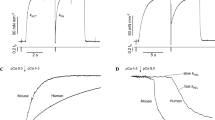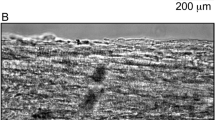Abstract
An electron microscope study is reported of structural changes during ATP-induced contraction of glycerinated rabbit psoas. In the absence of ATP, A-band length is constant at sarcomere lengths above 1.9 μm, with average length of 1.54 μ. In ATP-treated fibers, A-band length is also constant at sarcomere lengths above 2.0 μm, but the apparent length of A-band decreases to approximately 1.3 μm, as sarcomere length decreases from 1.9 μm to 1.5 μ. The occurrence of short A-bands cannot be attributed to crumpling of thick filaments against Z-lines, since I-bands remain patent; nor to the presence of heterogeneous filaments, since resting muscle does not show comparable heterogeneity, nor to compressive artifacts, which are minor when knife edge is oriented parallel with fiber axis during microtomy. The decrease of A-band length appears related, at least in part, to disarray of terminal cross-bridges as the thick filaments encroach upon the N-line, a structure which becomes evident within the I-band during contraction of glycerinated fibers. In preliminary studies, optical transforms of A-bands from individual sarcomeres reveal a characteristic myosin layer-line pattern as low as 1.5 μm sarcomere length. A cross-bridge repeat of 143 Å is obtained for sarcomeres above 1.6 μm length; however, an appreciable proportion of sarcomeres in the range from 1.5 μm to 1.9 μ length generate meridional reflections less than 143 Å, and as low as 130 Å.
Access this chapter
Tax calculation will be finalised at checkout
Purchases are for personal use only
Preview
Unable to display preview. Download preview PDF.
Similar content being viewed by others
References
Berger, J.E., Zobel, C.R. and Engler, P.E. (1966). Laser as light source for optical diffractometers; Fourier analysis of electron micrographs. Science 153: 168–170.
Berger, J.E. and Harker, D. (1967). Optical diffractometer for production of Fourier transforms of electron micrographs. Rev. Sci. Inst. 38: 292–293.
Craig, R. (1977). Structure of A-segments from frog and rabbit skeletal muscle. J. Mol. Biol. 109: 69–81.
Franzini-Armstrong, C. and Porter, K.R. (1964). The Z-disc of skeletal muscle fibers. Z. Zellforsch. 61: 661–672.
Franzini-Armstrong, C. (1970). Details of the I-band structure as revealed by the localization of ferritin. Tissue and Cell. 2: 327–338.
Hanson, J. and Huxley, H.E. (1955). The structural basis of contraction in striated muscle. Symp. Soc. Expt. Biology. 9: 228–264.
Hanson, J. (1988). X-ray diffraction of muscle. Quart. Rev. Biophysics. 1: 177–216.
Haselgrove, J.C. and Huxley, H.E. (1973). X-ray evidence for radial cross-bridge movement and the sliding filament model in actively contracting skeletal muscle. J. Mol. Biol. 77: 549–568.
Haselgrove, J.C. (1975). X-ray evidence for conformational changes in the myosin filaments of vertebrate striated muscle. J. Mol. Biol. 92: 113–143.
Herman, L. and Dreizen, P. (1971). Electron microscopic studies of skeletal and cardiac muscle of a benthic fish. I. Myofibrillar structure in resting and contracted muscle. Amer. Zoologist. 11: 543–557.
Huxley, A.F. and Niedergerke, R. (1954). Structural changes in muscle during contraction. Interference microscopy of living muscle fibers. Nature. 173: 971–973.
Huxley, H.E. and Hanson, J. (1954). Changes in the cross-striations of muscle during contraction and stretch and their structural interpretation. Nature. 173: 973–976.
Huxley, H.E. (1957). The double array of filaments in cross-striated muscle. J. Biophys. Biochem. Cytology. 3: 631–647.
Huxley, H.E. (1980). Muscle Cells. In: The Cell, Vol. 4, pp. 365–481, ed. Brachet, J. and Mirsky, A.R. New York, Academic Press.
Huxley, H.E. (1963). Electron microscopic studies on the structure of natural and synthetic protein filaments from striated muscle. J. Mol. Biol. 7: 281–308.
Huxley, H.E. (1965). Structural evidence concerning the mechanism of contraction in striated muscle. In: Muscle. pp. 3–28. Paul, W.M., Daniel, E.E., Kay, C.M., and Monkton, G. Oxford, Pergamon Press.
Huxley, H.E. and Brown, W. (1967). The low-angle X-ray diagram of vertebrate striated muscle and its behavior during contraction and rigor. J. Molec. Biol. 30: 383–434.
Huxley, H.E. (1968). Structural difference between resting and rigor muscle; evidence from intensity changes in the low-angle equatorial X-ray diagram. J. Molec. Biol. 37: 507–520.
Kensler, R.W. and Levine, R.J.C. (1982). An electron microscopic and optical diffraction analysis of the structure of Limulus telson muscle thick filaments. J. Cell Biol. 92: 443–451.
Klug, A. and Berger, J.E. (1964). An optical method for the analysis of periodicities in electron micrographs, and some observations on the mechanism of negative staining. J. Mol. Biol. 10: 565–569.
Knappeis, G.G. and Carlsen, F. (1962). The ultrastructure of the Z-disc in skeletal muscle. J. Cell Biol. 13: 323–335.
Luft, J.H. (1961). Improvements in epoxy resin embedding methods. J. Biophys. Biochem. Cytology. 9: 409–414.
O’Brien, E.J., Bennett, P.M. and Hanson, J. (1971). Optical diffraction studies of myofibrillar structure. Phil. Trans. Roy. Soc. Lond. B. 261: 201–208.
Page, S.G. and Huxley, H.E. (1963). Filament lengths in striated muscle. J. Cell Biology. 19: 369–390.
Page, S.G. (1968). Fine structure of tortoise skeletal muscle. J. Physiol. 197: 709–715.
Reynolds, E.S. (1963). The use of lead citrate at high pH as an electron-opaque stain in electron microscopy. J. Cell Biology. 17: 208–212.
Sabatini, D.D., Bensch, K.G. and Barnett, R.J. (1963). Cytochemistry and electron microscopy. The preservation of cellular structures and enzymatic activity by aldehyde fixation. J. Cell Biology. 17: 19–58.
Samosudova, N.V. and Frank, G.M. (1971). Change in the ultrastructure of contractile apparatus of striated muscle under toxic contraction. Biophysika. 16: 244.
Samosudova, N.V., Lyudkovskaya, R.G. and Frank, G.M. (1972). Ultrastructural studies of slow and intermediate isolated frog muscle fibers under toxic contraction. Biophysika. 17: 1055.
Sjostrand, F.S. and Jagendorf-Elfvin, M. (1967). Ultrastructural studies of the contraction-relaxation cycle of glycerinated rabbit psoas muscle. I. The ultrastructure of glycerinated fibers contracted by treatment with ATP. J. Ultrastruct. Research. 17: 348–378.
Squire, J. (1981). The Structural Basis of Muscular Contraction. New York, Plenum Press.
Stempak, J.G. and Ward, R.T. (1964). An improved staining method for electron microscopy. J. Cell Biology. 22: 697–701.
Yarom, R. and Meiri, U. (1971). N-lines in striated muscle: a ffite of intracellular Ca2+. Nature. 234: 254–256.
Author information
Authors and Affiliations
Editor information
Editors and Affiliations
Rights and permissions
Copyright information
© 1984 Plenum Press, New York
About this chapter
Cite this chapter
Dreizen, P., Herman, L., Berger, J.E. (1984). Structural Studies of Glycerinated Skeletal Muscle. I. A-Band Length and Cross-Bridge Period in ATP-Contracted Fibers. In: Pollack, G.H., Sugi, H. (eds) Contractile Mechanisms in Muscle. Advances in Experimental Medicine and Biology, vol 37. Springer, Boston, MA. https://doi.org/10.1007/978-1-4684-4703-3_12
Download citation
DOI: https://doi.org/10.1007/978-1-4684-4703-3_12
Publisher Name: Springer, Boston, MA
Print ISBN: 978-1-4684-4705-7
Online ISBN: 978-1-4684-4703-3
eBook Packages: Springer Book Archive




